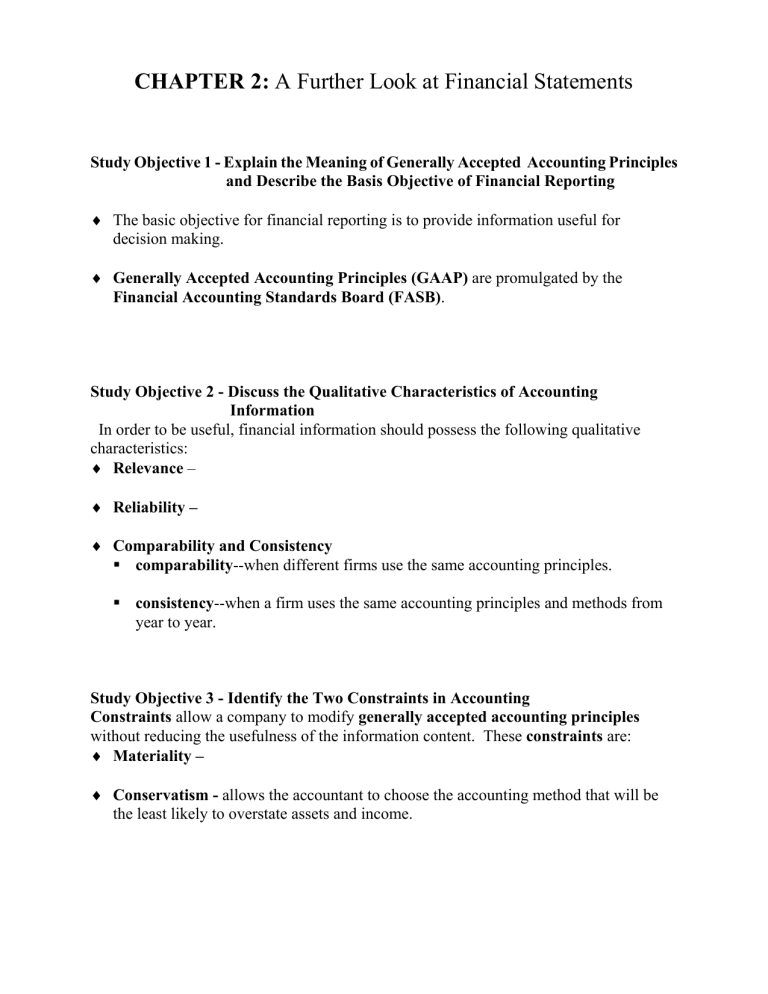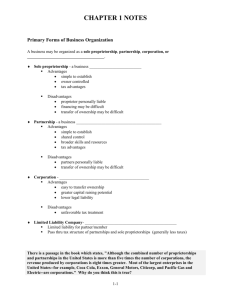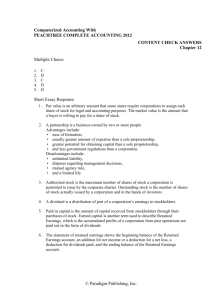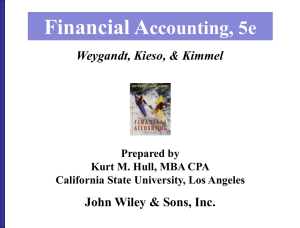CHAPTER 2:

CHAPTER 2: A Further Look at Financial Statements
Study Objective 1 - Explain the Meaning of Generally Accepted Accounting Principles and Describe the Basis Objective of Financial Reporting
♦ The basic objective for financial reporting is to provide information useful for decision making.
♦ Generally Accepted Accounting Principles (GAAP) are promulgated by the
Financial Accounting Standards Board (FASB) .
Study Objective 2 - Discuss the Qualitative Characteristics of Accounting
Information
In order to be useful, financial information should possess the following qualitative characteristics:
♦ Relevance –
♦ Reliability –
♦ Comparability and Consistency
comparability --when different firms use the same accounting principles.
consistency --when a firm uses the same accounting principles and methods from year to year.
Study Objective 3 - Identify the Two Constraints in Accounting
Constraints allow a company to modify generally accepted accounting principles without reducing the usefulness of the information content. These constraints are:
♦ Materiality –
♦ Conservatism - allows the accountant to choose the accounting method that will be the least likely to overstate assets and income.
Study Objective 4 - Identify the Sections of a Classified Balance Sheet
In a classified balance sheet companies often group similar assets and similar liabilities together as they have similar economic characteristics. The groupings help users to determine (1) whether the company has enough assets to pay its debts and (2) the claims of short-and long-term creditors on total assets.
A classified balance sheet generally contains the following standard classifications:
♦ Current Assets
Assets that are expected to be converted to cash or used in the business within a short period of time, usually one year.
Examples of current assets include:
On the balance sheet, current assets are listed in order of _______________.
♦ Long-Term Investments
Assets that can be converted into cash, but whose conversion is not expected
within one year.
Examples are
♦ Property, Plant, and Equipment
Assets with relatively long useful lives.
Examples include
Accumulated depreciation is subtracted in calculating net property, plant, and equipment.
♦ Intangible Assets
Non current assets.
Assets which have no physical substance.
Examples are patents, copyrights, and trademarks or trade names.
♦ Current Liabilities
Obligations that are supposed to be paid within the coming year.
Common examples are
♦ Long-Term Liabilities
Obligations expected to be paid after one year.
Liabilities in this category include
2-2
♦ Stockholders’ Equity
Capital Stock - investments in the business by the stockholders.
Retained earnings - earnings retained for use in the business.
Study Objective 5 Identify and Compute Ratios for Analyzing a Company’s
Profitability.
Creditors and investors are interested in evaluating profitability. Profitability is frequently used as a test of management’s effectiveness. To supplement an evaluation of the income statement, ratio analysis is used.
♦ Profitability ratios - measure the income or operating success of an enterprise for a given period of time.
Earnings per share
• Measures the __________________________________________
• computed by dividing net income by average number of common shares outstanding during the year
• evaluates the relative earnings performance from the perspective of a shareholder
Price-Earnings ratio
• measures the ____________________________________________
• computed by dividing the stock price per share by Earnings per share
• reflects the investors’ assessment of a company’s future earnings
Study Objective 6 - Explain the Relationship Between a Retained Earnings
Statement and a Statement of Stockholders’ Equity
♦ Retained Earnings Statement
Describes the events that caused changes in the retained earnings account for the period.
Add net income and subtract dividends from beginning balance of retained earnings to arrive at ending balance of retained earnings.
♦ Statement of Stockholders’ Equity
Reports all changes in stockholders’ equity accounts (i.e., capital stock issued or retired).
2-3
Study Objective 7 - Identify and Compute Ratios for Analyzing a Company’s
Liquidity and Solvency Using a Balance Sheet
An analysis of the relationship between a company’s assets and liabilities can provide users with information about the firm’s liquidity and solvency.
♦ Liquidity - The ability to pay obligations as they come due.
Working capital
• Measure of short term ability to pay obligations.
• Excess of _______________ over _________________.
• Positive working capital indicates the likelihood for paying liabilities is favorable.
Current ratio
• Measure of short term ability to pay obligations.
• Computed by dividing current _____________ by current ________________.
• More dependable indicator of liquidity than working capital.
• Does not take into account______________________.
♦ Solvency - The ability of the enterprise to survive over a long period of time.
Debt to Total Assets Ratio
• Measures the percentage of assets financed by creditors.
• The higher the percentage of debt financing,____________________.
• Computed by dividing total debt (both current and long-term liabilities) by total assets.
Study Objective 8 - Identify and Compute Ratios for Analyzing a Company’s
Liquidity and Solvency Using a Statement of Cash Flows
The statement of cash flows provides financial information about the sources and uses of a company's cash. To aid in the analysis of cash, the statement of cash flows reports the cash effect of company's:
♦ Financing activities - Cash inflows from sources funding the business (i. e. sale of stock, sale of bonds, borrowings, etc.).
♦ Investing activities - Cash outflows from purchasing resources needed in operating the business.
♦ Operating activities - Cash inflows and cash outflows associated with the primary operations of the business.
2-4






